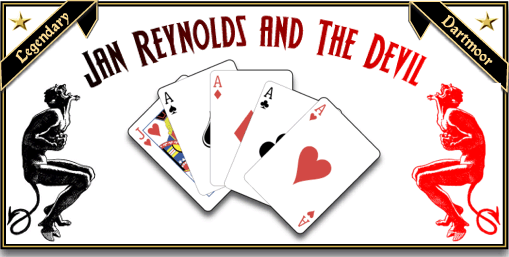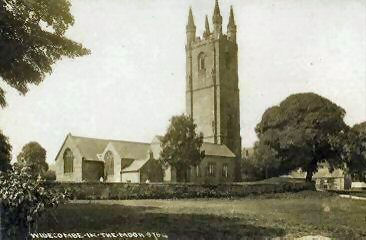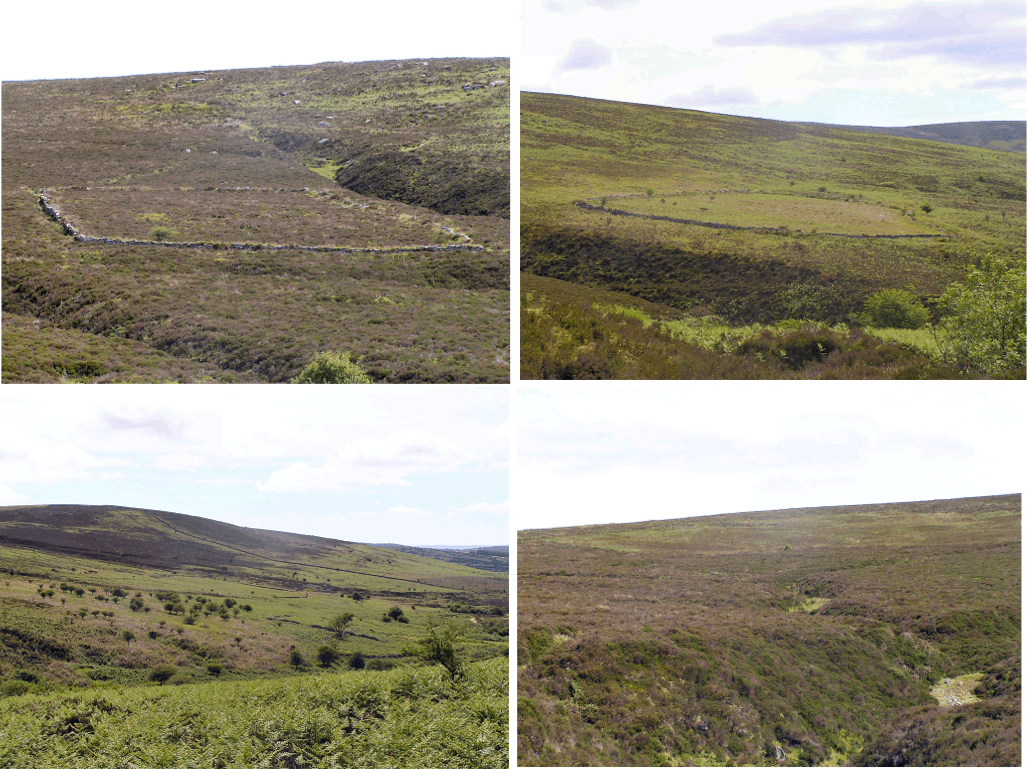
Jan Reynolds was a young tin miner who lived in Widecombe. He worked hard but played even harder, in the area he was known as a drinker, gambler and a womaniser. Sadly his lifestyle did not match his income and so he was always short of ‘coin’. In an attempt to solve this problem Jan had sold his soul to the Devil in return for gold. The upturn in his fortune enabled the young miner to indulge even further in his passions and he became so engrossed that he conveniently forgot his satanic pact.
One Sunday morning a group of ‘church dodgers’ were having a few pints in the Tavistock Inn at Poundsgate. This was a regular venue for a Sunday because it was far enough away from Widecombe for the vicar to catch them. This particular Sunday was hot, humid and sultry which meant the locals had a proper thirst on. The ale was flowing fast and furious and the landlady’s till was filling nicely. Those sat near the window became aware of the sound of galloping hooves clattering down the road. The horse and rider slid to a halt outside the inn upon which a tall dark stranger dismounted and purposefully strode into the bar. He was dressed from head to toe in black and had an menacing air about him. The rider stood and the bar and slowly surveyed the crowd of locals. The low murmur of conversation stopped and feet scuffled nervously on the floor. Everybody was looking anywhere but at the stranger who continued to carefully examine each individual. The landlady edged up and asked the man what he would like to drink. A foaming tankard of ale was duly poured and a gold coin handed over. Those near enough were amazed to see such a sum, this was not rich men’s company. Those who stood even nearer were alarmed to hear a sizzling noise coming from the strangers throat as he quaffed his ale. With one final look around the bar the man in black finished his drink and strode out. The sound of galloping hooves could once again be heard speeding off towards Widecombe. One of the locals asked to see the gold strangers gold coin and so the landlady reached into cash box. To her surprise she found only a few pennies and a pile of dry, withered leaves where she had put the golden guinea.
Whilst all this was happening, Jan Reynolds had decided to go to church over at Widecombe where he was hoping to catch the eye of a certain milk maid. The vicar was not known for a short sermon and so to pass the time Jan was playing idly with a pack of cards. As the minutes dragged by his eyes became heavy and soon the young miner fell asleep. The vicar droned on and on until a sudden flash of lightening lit the church. This was followed by a loud crack of thunder which announced the arrival of a terrible storm. Suddenly there was an enormous crash, dust and debris showered down from the roof and to everybody’s terror the Devil plummeted down into the church. He strode over to where the sleeping figure of Jan Reynolds was and scooped him up. Amongst all this mayhem folks were confused to say the least, some say that before he returned up to the tower the devil bashed Jan’s skull in, others say Satan simply carried him up to the tower. Either way, the evil one went to his horse which he had tethered to one of the churches pinnacles, flung the miner across its neck and then leapt on the animals back. With a spine chilling shriek, the Devil sped off with a hail of sparks and flames into the stormy sky. As the horse leapt into the air it tore off the pinnacle and sent it crashing down into the church.
The last anyone ever saw of Jan Reynolds was when they passed over the moor by the Birch tor mine, the Devil was holding the figure of the lad and the horse was climbing higher into the sky. As the horse ascended four of the playing cards fell from Jan’s pocket and fluttered down to earth. When the cards hit the ground they left four imprints which serve as a warning to all potential ‘soul sellers’ and anyone who dared to play cards in church.
Widecombe has been called the ‘valley of thunderstorms’ and on the 21st of October 1638 an exceptionally violent storm occurred. It struck Widecombe in the afternoon and being a Sunday many people were attending the afternoon service. A huge thunderbolt hit the church roof and sent masonry and debris flying down into the congregation, resulting in six people being killed and sixty two injured. In an account of 1638 entitled “A true relation of those strange and lamentable accidents which happening in the Parish Church of Wydecombe, near the Dartmoors in Devonshire,” the authors, Masters Wykes and Rothwell, detail the events of the storm. The whole account is too long to record here but the following are pertinent extracts:
“I here present thee with a second relation of that wonderful accident which the printing of the former book hath given occasion of. Having now received a full and perfect relation as is possible to be hoped for, or procured, assuring thee it is not grounded on information taken up at second hand; but those persons being now come to London, who were eye-witnesses herein, and the chiefest discoverers of the effects of these terrible accidents…
Upon Sunday the 21st October last, in the parish church of Wydecombe, near the Dartmoors, in Devonshire, there fell, in time of Divine service, a strange darkness, increasing more and more, so that the people there assembled could not see to read in any book; and suddenly, in a fearful and lamentable manner, a mighty thundering was heard, the rattling whereof did answer much like unto the sound and report of many cannons, and terrible strange lightening therewith greatly amazed those that heard and saw it, the darkness increasing yet more, so that they could not see one another; the extraordinary lightening came into the church so flaming, that the whole church was presently filled with fire and smoke, the smell whereof was very loathsome, much like unto the scent of brimstone; some say they saw at first a great fiery ball come in at the window, and pass through the church, which so affrighted the whole congregation, that the most part of them fell down in their seats, and some upon their knees, some on their faces, and some one upon another, with a great cry of burning and scalding…
The minister of the parish, Master George Lyde, being in the pulpit, however he might be much astonished hereat, yet through God’s mercy, had no harm at all in his body… The lightening seized upon his poor wife, fired her ruff, and linnen next to her body, and her clothes, to the burning of many parts of her body in a very pitiful manner. And one Mrs Ditford, sitting in the pew with the ministers wife, was also much scalded…
Besides, another woman adventuring to run out of the church, had her clothes set on fire, and was not only strangely burnt and scorched, but had her flesh torn about her back, almost to the very bones. And one ancient woman was so terribly burnt, and her flesh torn, especially her hand, the flesh was so rotten and perished, that her hand is cut off that it might not endanger her arm. Another woman had her flesh so torn, and her body so grievously burnt, that she died the same night…
Also, one Master Hill (Roger), a gentleman of good account in the parish, sitting in his seat by the chancel, had his head suddenly smitten against the wall, through the violence whereof he died that night…
There was also one man more at the same instant, of whom it is particularly related, who was warrener unto Sir Richard Reynolds, his head was cloven, his skull rent into three pieces, and his brains thrown upon the ground, whole, and the hair of his head, through the violence of the blow first given him, did stick fast to the pillar or wall of the church, and in the place a deep bruise into the wall, as if it were shot against with a cannon bullet…
Some other persons were then blasted and burnt, and so grievously scaled and wounded, that since that time they have died thereof, and many others not like to recover, not withstanding all the means that can be procured to help them. Some had their clothes burnt, and their bodies had no hurt; and some, on the contrary, had their bodies burnt and their clothes not touched; and some their stockings and legs burnt and scalded, and their outward buskins (knee high boot of leather or cloth) not one thread singed…

Widecombe Church – William Spreat – 1842
There were some seats in the body of the church turned upside down, and yet they which sat therein had little or no hurt; also a boy, sitting on his seat, has his hat on, and near the one half thereof was cut off, and he had no hurt. And one man, going out at the chancel door, a dog, running out before him, was whirled about towards the door, and fell down stark dead, at sight whereof he stepped back within the door, and God preserved him alive.
Also, the church itself was much torn and defaced by the thunder and lightening; and thereby, also, a beam was burst in the midst, and fell down between the minister and clark, and hurt neither; and a weighty great stone, near the foundation of the church, is torn out and removed, and the steeple itself is much rent, and there, where the church was most rent, there was least harm done to the people, and not any one was hurt wither with wood or stone, but a maid of Manaton, which came thither that afternoon to see some friends, whom Master Frynd, the coroner, by circumstances supposed she was killed by a stone. There were also stones thrown from the tower, and carried about, a great distance from the church, as thick as if a hundred men had been there throwing, and a number of them of such weight and bigness, that the strongest man cannot lift them, Also one pinnacle of the tower was torn down, and broke through into the church.
Moreover the pillar against which the pulpit standeth being but newly whitened, is now, by this means, turned black and sulphury. Furthermore, one man that stood in the chancel with his face towards the belfry, observed, as it were, the rising of dust or lime, in the lower end of the church, which suddenly, as with a puff of wind, was whirled up, and cast into his eyes, so that he could not see in twelve hours after…
The terrible lightening being past, all the people being in wonderful amaze, so that they spake not one word, by and by one Master Ralph Rowse, vintner in town, stood up saying these words:- “Neighbours, in the name of God, shall we venture out of the church?” To which, Mr Lyde, answering, said, “It is best to make an end of prayers, for it were better to die here than in another place.” But they looking about them, and seeing the church so terribly rent and torn, durst not proceed in their publick devotions, but went forth from the church.
And as all this was done within the church and unto the church, so there were other accidents without the church, whereof I will give you at touch. There was a bowling-alley near unto the church-yard, which was turned up into pits and heaps, in a manner almost as if it had been plowed. At the same time also at Brickstone, near Plymouth, there fell such store of hail, and such hailstones, that for quantity they were judged to be as big as ordinary turkey eggs; some of them were of five, some of six and others of seven ounces weight,” Dymond, 1876, pp 88-103.

Widecombe Church.
The register of burials list fifteen names up until the 13th of October 1638 which are then followed by:
Hill, Roger, Gent – 23 October
Meade, Robertt – 23 October
Milward, Sibella – 23 October
Hamlyn, Susan (wife of James) – 23 October
Sheere, Walter – 1 November
Beard, Bridgett Wid. – 6 November
No further burials are then listed until the 31st January 1639. Therefore it is possible that Sibella Milward was the ‘visiting maid from Manaton’, the widow Bridgett Beard was either ‘another woman had her flesh so torn’ or the ‘ancient woman’ and the warrener was Robertt Meade.
Woods, 1996 p.50 notes that according to Mrs Bray, a similar occurrence happened on the 23rd of February 1752 when a shock from an earthquake knocked down another pinnacle, this time there were no injuries. The events were also recorded in the form of a poem, it was written on wooden panels and was said to be the work of the village schoolmaster, Richard Hill who was the son of the Roger Hill who was killed in the incident. The Rev. George Lyde was also moved to record the events in verse, his work spans 5 pages and can be seen in Dymond’s book.
I am not sure which is more scary, the legend or above account. The local belief was that the disaster was the work of the Devil and there is a story that when a small boy was asked “where can the Devil be found,” he replied to his teacher “If you please ma’am he lives to Widecombe.”

The Aces Fields or Jan Reynold’s Cards.
With regard to the last part of the legend, there are to this day four enclosures which are known as the ‘ Aces’, ‘Four Aces’ or ‘Jan Reynold’s Cards’. These can be found just to the east of Birch tor and were enclosures used by the miners and warreners. In the southernmost one the miners grew vegetables and in the other three the warreners grew furze for feeding to the rabbits. Three of the enclosures appear on the 1839 tithe map and are named, going from north to south as Heath Close, Sandy Park and Brake, Hemery, 1983, pp612-3. Clearly if you are growing any kind of crop near a rabbit warren you need protective, rabbit proof walls of which these enclosures are fine examples.

Dymond, R. (ED.) 1876 Widecombe in the Moor, Torquay Directory Company, Torquay.
Hemery, E. 1983 High Dartmoor, Hale, London.
Woods, S. 1996, Widecombe in the Moor, Halsgrove, Tiverton.
 Legendary Dartmoor The many aspects past and present of Dartmoor
Legendary Dartmoor The many aspects past and present of Dartmoor

Hi Tim,
Are you able to give me the exact locations of the Devil’s playing cards fields?
Just a screen shot of a map with a dot on each would be great.
Map extract sent.
Truly interesting story, if riddled with comma splices.